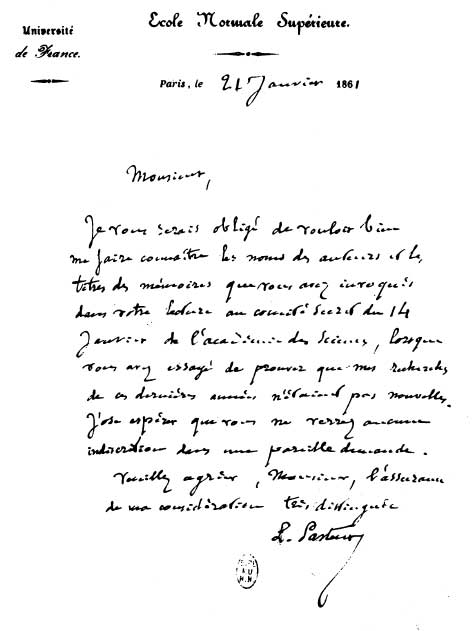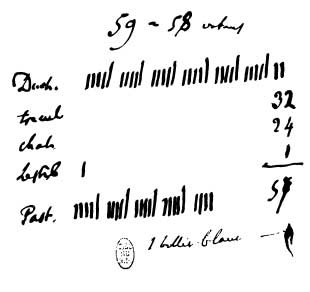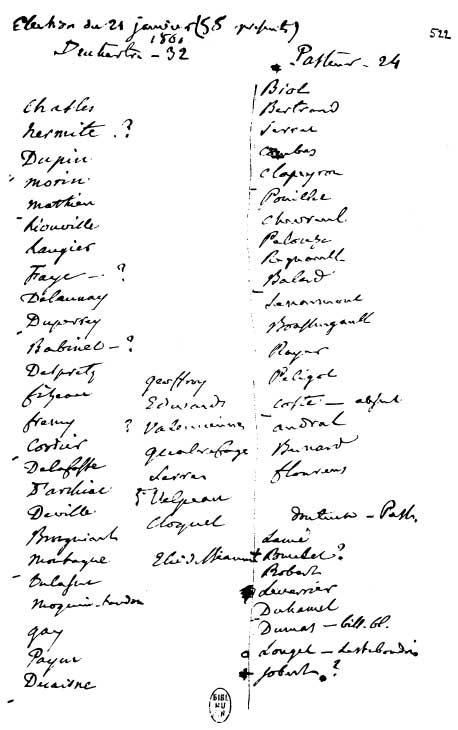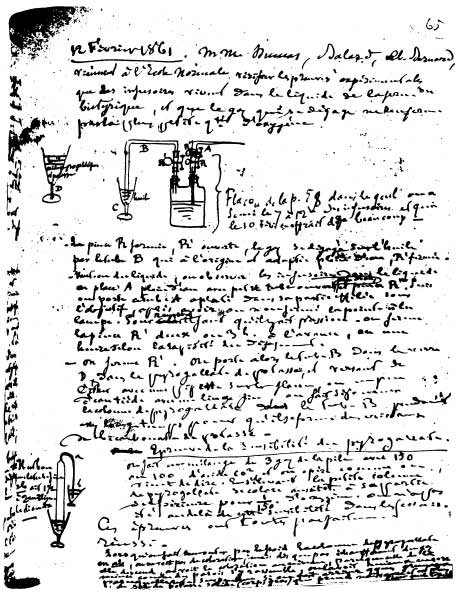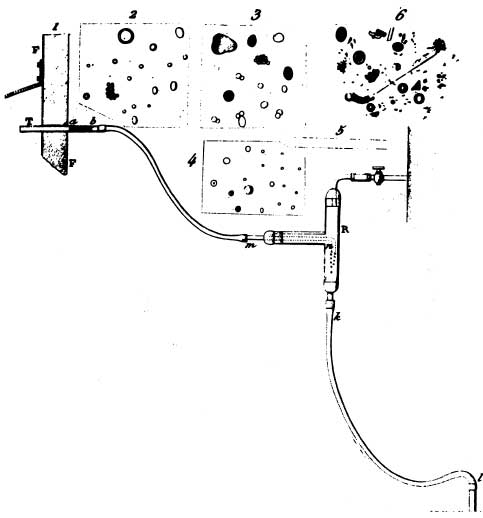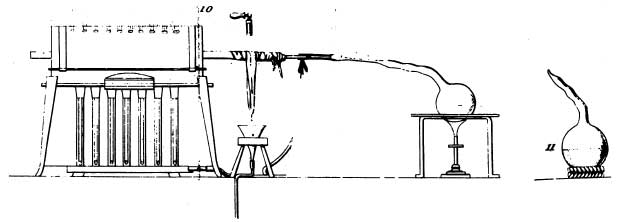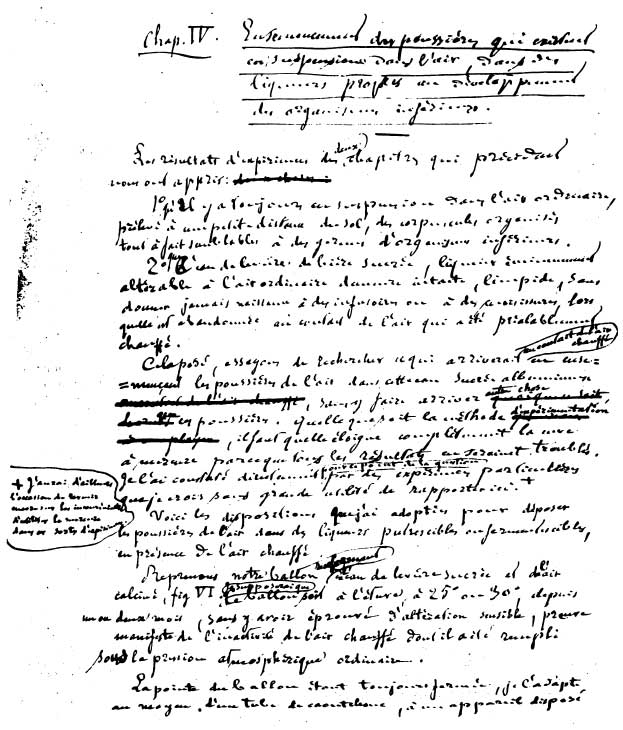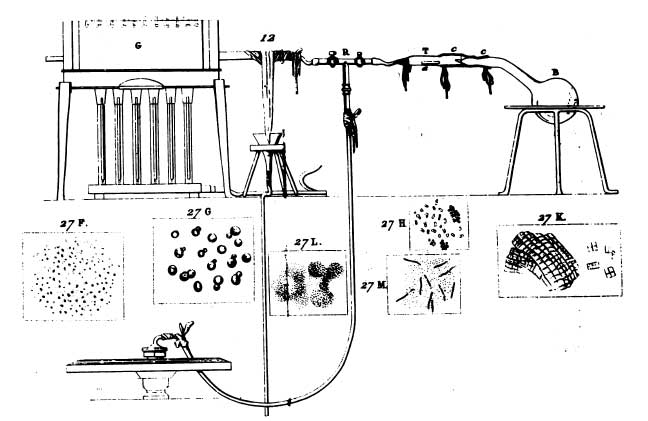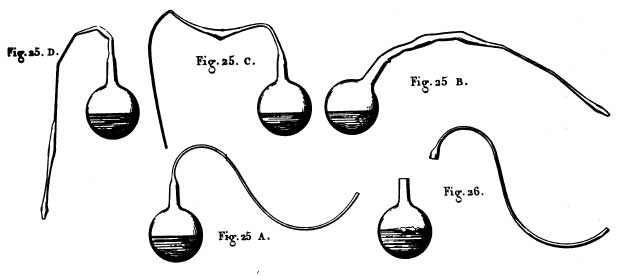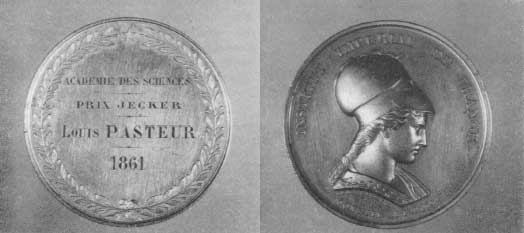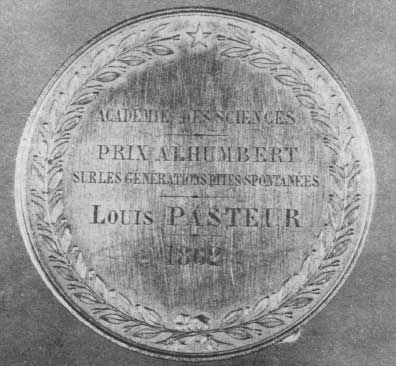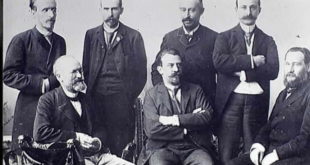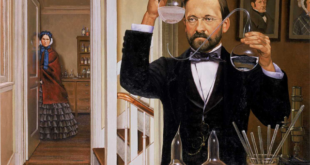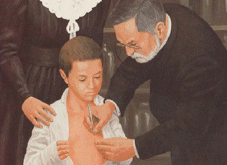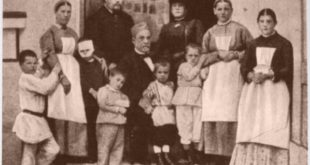Department of Bacteriology, College of Medicine, State University of Iowa, Iowa City, Iowa
After considering various subjects for this occasion, I decided, because it is the 100th Anniversary of some of Louis Pasteur’s most important research and publications, to pay respect to him and, as Emil Roux stated, “relate what nobody should be ignorant of in Pasteur’s life, and what all who are engaged in scientific work should know of the achievements of this great man.”
In retrospect, the year 1861 was one of the more eventful years in Pasteur’s life. It was filled with Louis Pasteur’s achievements, honor, and joy, but also with affront, discouragement, and sadness. At the beginning of 1861, Pasteur had just passed his 38th birthday, the 27th of December. He was married and the father of four children. He had held positions in three universities, and was at the time Professor, Administrator, and Director of Scientific Studies at the Superior Normal School in Paris. His research was outstanding, and since 1847 he had published 75 memoirs, notes, and papers on such diverse subjects as molecular asymmetry, lactic fermentation, alcoholic fermentation, and the production of glycerol and succinic acid by yeast. Each report contained true Pasteurian discoveries. He had been awarded three prizes, including the coveted Rumford Medal from the Royal Society of London. His pastel drawings, especially of people, were recognized as outstanding pieces of art. Few scientists accomplish this much in an entire lifetime. But now let us review 1861 chronologically.
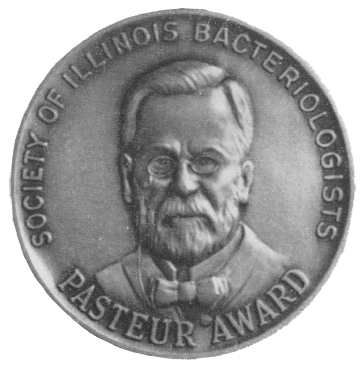
“I can hear the objection: he is a chemist, a physicist, not a professional botanist…. But that very versatility, ever active and ever successful, should be in his favor…. Let us judge of men by their works and not by the destination more or less wide or narrow that they have marked out for themselves. Pasteur made his debut before the Academy in 1848, with the remarkable treatise which contained by implication the resolution of paratartaric acid into its two components, right and left. He was then 26; the sensation produced is not forgotten. Since then,during the 12 years, he has submitted to your appreciation numerous papers, the last 10 relating to vegetable physiology. All are full of new facts, often very unexpected, several very far reaching, not one of which has been found inaccurate by competent judges. If today, by your vote, you introduce M. Pasteur into the Botanical Section as you might safely have done for Theodore de Sassure or Ingenhousz, you will have acquired for the Academy and for that particular section an experimentalist of the same order as those two great men.”
Many scientists, including Professor Balard, the great French chemist who discovered bromine, and Dr. Claude Bernard, the famous
physiologist, supported Biot in this academic campaign and tried to persuade several members of the Botanical Section to include Pasteur’s name on the list recommended by their section.
FIG 1. Pasteur’s letter to M. Brongniart.
The list of candidates, picked by a secret committee of the Section of Botany, appeared (2) in the minutes of the meeting of the Academy for Monday, the 14th day of January 1861:
COMITÉ SECRET.
La Section de Botanique presente, par l’organe de son doyen M. Brongniart, la liste suivante de candidats pour la place vacante par suite du d6cbs de M. Payer:
En premiere ligne. M. DUCHARTRE
En deuxibme………. M. TRACUL
En troisierne, ex aequo et par fM. CHATIN
ordre alphabetique……… .M. LESTIBOUDOIS
Pasteur knew of his opposition after the secret meeting, and on January 21, election day, he wrote the following letter to the senior member of the Section, Professor Adolphe Brongniart (Fig. 1):
“I would be obliged to you if you would be willing to make known to me the names of the authors and the titles of the memoirs that you invoked in your reading to the secret committee of 14 January of the Academy of Science, when you tried to prove that my research of these last years was not new. I dare to hope that you will see no indiscretion in such a request…”
Despite the opposition, Pasteur’s name appeared as a write-in on many ballots that day (Fig. 2). Thirty votes were required for election. Pasteur had only 24; Duchartre was elected with 32 votes. Interestingly, Brongniart carefully weighed the chances of Pasteur and Duchartre before the election, and listed on a sheet of paper the names of possible supporters (Fig. 3). Brongniart also communicated to Pasteur on the 23rd of January the list of the principal articles that were used by the committee in attempting to disprove the originality of his work.
Pasteur and his colleagues were disappointed about the election, because it was Pasteur’s second defeat for admission to the Academy. Biot died early in 1862 before realizing one of his great wishes. The Academy will be mentioned again frequently, but now I wish to continue with the next specific event in Pasteur’s life.
FIG 3. Brongniart’s list of people who voted for
Duchartre and Pasteur in Academy of Sciences
Nearly 200 years before, Leeuwenhoek reported in his 32nd letter to the Royal Society of London that “animalcules” could exist in a highly rarefied atmosphere. This observation was not extended until anaerobiosis and the true nature of fermentation were discovered by Pasteur in 1861.
On the 11th of February, Pasteur wrote to A. J.-B. Dumas asking him to come with M. Balard and M. Bernard “to my laboratory to verify the exact facts” of the interesting experiments demonstrating life without air. Pasteur knew that if he could convince his colleagues of his discovery, Dumas would gladly introduce the results to the Academy. A page (Fig. 4) from Pasteur’s laboratory notebook shows some of the original illustrations of one of these experiments, and part of the results.
But, on the 17th of February, a second letter was sent to Dumas requesting that he delay 8 or 15 days reporting the results to the Academy because he (Pasteur) wanted to “test the influence of free oxygen on the infusoria…and dispel any objections that my flasks contain traces of free oxygen sufficient to support life.”
FIG 4. Page 65 from Pasteur’s notebook, 12 February 1861,
describing experiments on life without oxygen.
The impact of the final presentation 10 days later by Dumas before the Academy is indicated in the following short letter Pasteur wrote to his father:
Paris, le 27 février 1861
Mon cher papa,
…Vois le Constitutionnel de mardi 26 février. Tu y verras que M. Dumas a présenté lundi dernier ma déscouverte à l’Académie et qu’elle a fait sensation. Adieu. J t’embrasse bien.
L. Pasteur
The first report dealt with the butyric ferment. Pasteur found that when he added a drop of a liquid undergoing butyric-acid fermentation to a solution containing a salt of lactic acid, the lactate was transformed to butyrate, with evolution of the gases CO2 and H2. Simultaneously, a microscopic population appeared, which consisted of short cylindrical rods that were motile. Pasteur called these rods “Vibriones.” Because of the prevailing view that motility was one of the differential characteristics between the animal and plant kingdoms, Pasteur regarded these Vibriones as minute animals and grouped them with the “Infusoria.” But for some time he was reluctant to believe that they were the real cause of the butyric acid fermentation. He said, “I was far from expecting such a result;…so far, indeed, that for a long time I thought it my duty to prevent the appearance of these little animals for fear they may feed on the microscopic plants which I suspected to be the true butyric ferment, and which I was trying to discover…Finally, I was struck by the inevitable coincidence between the infusoria and the production of this [butyric] acid.
On the 30th of March and the 12th of April, Pasteur told the Chemical Society of Paris that yeasts ferment most efficiently in the absence of air, whereas they grow more abundantly in its presence. He also stated that, under anaerobic conditions, a yeast cell respires with the oxygen borrowed from the fermentable substance. These observations led him to suggest again that there is a correlation between life without oxygen and the ability to cause fermentation. In two other papers that spring, Pasteur presented his theory of fermentation in precise terms:
“In addition to the living forms so far known, which…can respire and feed only by assimilating free oxygen, there appears to be a class of beings capable of living without air by obtaining oxygen from certain organic substances which undergo a slow and progressive decomposition during the process of their utilization. This latter class of organized cells [Vibrion butyrique] constitutes the ferments, similar in all particulars to those of the former class, assimilating in the same manner carbon, nitrogen, and phosphates, requiring oxygen like them, but differing from them in the ability to use the oxygen removed rom unstable organic combinations instead of free oxygen gas for their respiration.”
This in brief was the discovery of anaerobiosis.
In addition to continuing his studies on fermentation at that time, Pasteur entered the controversy over the origin of life. In 1858 and 1859 Felix Puchet, Director of the Natural History Museum at Rouen, presented results in which he claimed to have produced spontaneous generation at will by admitting air to sterilized putrescible matter under carefully chosen conditions. He regarded his experiments as the final demonstration that life could originate anew from inanimate solutions. Pouchet’s claims revived the great controversy over the origin of life, and produced much excitement in scientific circles. Nevertheless, he was severely criticized by many leading French scientists. Pasteur was prepared by his studies in fermentation to attack the problem of spontaenous generation, and was convinced that the solution of the problem was essential, despite discouragement from Biot, Bernard, and other other colleagues from working on this difficult and apparently unsolvable problem. Pasteur’s experiments on this problem have acheived great and deserved fame. But even more interesting than their performance was the strategy of his attack on the subject. He acknowledged that somewhere in our universe life may still be created. But he raised the questions: “What can be done to evaluate the claims of those who pretend to have seen life emerge anew, or to have brought about conditions under which its spontaneous generation is possible?” He set himself to this task and devoted an immense amount of time to reading, writing, and carefully controlled experiments. Pasteur carried on a friendly but sharp correspondence with his opponents during this period, as illustrated by two letters addressed to Pouchet:
Paris, 3 April 1861
Dear Colleague,
The difference of our opinions on the famous question of spontaneous generation does not prevent me from esteeming highly your labor and praiseworthy efforts…The sincerity of these sentiments…permits me to have recourse to your obligingness in full confidence. I read with great care everything that you write onthe subject that occupies both of us. Now, I cannot obtain a brochure that I understand you have just published…I would be happy to have a copy of it because I am at present editing the totality of my observations, where naturally I criticize your assertions. I hope also to give soon a résumé of my work in a lecture before the Société Chimique…
L. Pasteur
Paris, 8 April 1861
Dear Colleague,
I thank you for the haste with which you sent me the brochure. How many things I have to answer to it! But let us speak…only of your amiable letter…You say, the yeast of beer forms spontaneously, germinates, and forms fruit…all that in a word, you affirm in your recent communication to the Academy of Sciences.
Well, my dear colleague, it is shown by me that there is not one of your assertions on yeast which has the slightest exactitude. All that has been written before by you…has not more value. If you can show me the yeast of beer giving an Aspergillus, I will surrender to you.
Please, my dear and learned colleague, read again my letter of February…and you will see that I never wrote you this sentence: “There are no more organic germs in the air than there are germs of sodium sulfate.”…
L. Pasteur
Pasteur presented brief reports of his work on spontaneous generation before the Academy of Science in 1860 and 1861, and finally published on the 19th of May and the 3rd of June, 1861, his famous 93-page Memoire sur les corpuscules organises qui existent dans l’atmosphere. Examen de la doctrine de generations spontaneres.
Of this research, Tyndall wrote: “Clearness, strength, and caution with consummate experimental skill for their minister were rarely more strikingly -displayed than in this imperishable essay.” This memoir inaugurated a new period in bacteriology. It should be studied by all who wish schooling in the art of rigorous experimentation and the scientific method.
Because of the important nature of this memoir, I will review it briefly. Pasteur began his studies on spontaneous
generation by attempting to repeat the results of Pouchet and others on the solid particles disseminated in air. He said:
“The procedure which I followed to collect the dust suspended in air and examine it with a microscope is very simple; it consists of filtering a determined volume of air on some guncotton [Fig. 5], soluble in a mixture of alcohol and ether. The fibers of cotton stop the solid particles. One then treats the cotton with its solvent. After some time, the solid particles fall to the bottom of the liquid; one washes them a few times…. In decanting the liquid it is good to use a siphon formed by a tube of small diameter that can be primed like a pump by aspiration. The particles are then put on the stage of the microscope where their study becomes easy….
The air examined … was normally aspirated in from the direction of Ulm Street or from the direction of the garden of the school … and was collected under diverse atmospheric conditions.”
FIG 5. Air filter used by Pasteur, and drawings of
microscopic particles collected on guncotton.
The next study designed by Pasteur was concerned with heated air. He described the experiment as follows:
“The slender neck of the balloon flask communicates with the red-hot platinum tube as the figure [Fig. 6] indicates.
One boils the liquid for 2-3 minutes, then lets it cool completely. The flask fills with ordinary air at atmospheric pressure, but all parts of which have been heated to redness … one closes with a lamp the neck of the balloon flask, which then has the form indicated [see 11, in Fig. 6].
The flask thus prepared is placed in an incubator at a constant temperature of 30 C … it can be kept there indefinitely, without the liquid which it encloses experiencing the slightest alteration. Its clearness, its odor, its characteristic of very feeble acidity … persist without appreciable change. Its color darkens slightly with time, without doubt under the influence of a direct oxidation of the sugared yeast water.
I affirm with the most perfect sincerity that I have never had a single experiment, arranged as I have just explained, which gave me a doubtful result.”
The third experiment described in the memoir is a classic, and is partially illustrated by a page (Fig. 7) from Pasteur’s original manuscript.
Chapter IV. Inoculation of growths, that exist in suspension in the air, into clear liquids suitable for the development of lower organisms.
The results of the experiments of the 2 preceding chapters have taught us:
1) That there are always suspended in ordinary air some organized corpuscles altogether like the germs of lower organisms.
2) That yeast-extract beerwort medium (the water of yeast of sugared beer), a very changeable liquid in .ordinary air, remains intact, clear, and without ever giving birth to infusoria or molds when it comes in contact only with air which has ,been previously heated.
That established, let us try to find out what would happen … upon inoculating in the medium the dust particles which we learned to gather (in Chapter II), without introducing anything other than these particles…. Here are the arrangements that I adopted to deposit the dust particles from air in the putrescible or fermentable liquids in the presence of heated air.
“Let us again use our flask containing sugar-yeast water and incinerated air…. I shall suppose that the flask has been in the incubator at 25 or 30 Cl, for 1 or 2 months, without having undergone any noticeable alteration, a manifest proof of the inactivity of the heated air with which it has been filled….
“The tip end of the flask still sealed, I fit it, by means of a rubber tube to an apparatus arranged as follows [Fig. 8]:
T is a tube of strong glass from 10-12 mm in diameter, in which I have placed a piece of glass tubing of small diameter a, open at its ends, free to slide in the large tube and enclosing a portion of one of those little wads of cotton laden with dust; R is a brass tube in the form of a T, provided with stopcocks, one of these stopcocks communicates with the pneumatic machine, another with a red-hot platinum tube, and the third with tube T; cc represents the rubber which unites flask B with tube T.
When all parts of the apparatus are arranged and the platinum tube is made red hot by the gas heater shown in G, one makes a vacuum, after having closed the stopcock that leads to the platinum tube. This stopcock is then opened so as to let the incinerated air enter the apparatus little by little. The vacuum and the return of the incinerated air are repeated alternately 10 to 12 times. The little tube of cotton thus is filled with the burned air to the smallest interstices of the cotton, but it has retained its dust particles. That done, I break the point of the flask B, through the rubber tube cc, without untying the cords, then I let the little tube with the dust particles slip into the flask. Finally, I again seal the tip of the flask with a lamp, and return the flask to the incubator. Now, it constantly happens that growth begins to appear in the flask after 24, 36, or 48 hours at the most.
Many experiments were performed using this technique, and samples of dust from air were taken on different days under varying atmospheric conditions.
FIG 6. Apparatus used for introducing
incinerated air into flasks.
Let us now return to Pasteur’s memoir and present his additional support for the disproof of spontaneous generation. He wrote:
“I believe I have rigorously established in the preceding chapters that all the organized production of infusoria … has no other origin than the solid particles which the air always carries and which it constantly deposits on all objects. If there remains the slightest doubt with respect to this in the mind of the reader, it will be removed by the experiments of which I am going to speak.
I place in a glass flask [Fig. 9] the following liquids or infusions, all very alterable on contact with ordinary air: beer-yeast water, sugar-beeryeast water, urine, beet juice, and pepper water; then with the aid of a lamp, I draw the necks of the flasks to give different shapes. I then bring the liquid to a boil for a few minutes until the water vapors leave abundantly by the end of the drawn-out neck…. I then let the flasks cool. A strange thing happens that will astonish everyone accustomed to the delicacy of experiments relative to so-called spontaneous generation; … the liquid in the flasks remains indefinitely without alteration. One can handle flasks without fear, move them from one place to another, let them undergo all the seasonal variations in temperature……” Later on he said, “this procedure is an excellent Appert method to preserve liquids….. “If after a stay of one or several months in the incubator, one detaches the neck of a flask … the molds and infusoria begin to grow in 24, 36, or 48 hours in exactly the same way as if the flask had been inoculated with dust particles collected from the air.
The same experiments can be repeated on milk, providing one takes a few precautions in boiling…and cooling…I have been able to keep milk prepared in this manner in the incubator at 25 to 30 C for several months without alteration. One notices only a slight thickening of the cream owing to direct chemical oxidation.”
FIG 7. Page from Pasteur’s original manuscript. Printed as pages 56 and 37 of Me’moire sur les corpuscules
organises qui existent dans l’atmosphere. Examen de la doctrine des generations spontankes. From
Ann. Sci. Naturelles
Pasteur’s explanation of what happens in such flasks is intersting. He wrote:
“It seems that ordinary air on entering the flask after boilign ceases in a crude state. During the first moments the air enters it encounters a liquid near boiling…When the liquid is cool enough so as no longer to rob germs of their vitality, the air enters so slowly that it abandons in the humid curves of the neck all dust particles capable of acting on the infusions…At least I see no other possible explanation for these curious experiments.”
FIG 8. Apparatus for introducing guncotton into flasks
containing fermentable materials and incinerated air.
These experiments were so carefully designed and controlled that they settled the issue of spontaneous generation, although the controversy continued for several years after 1861.
FIG 9. Pasteur Flasks.
Pasteur’s work on fermenation and spontaneous generation led to studies of the changes in alcoholic liquids during the formation of vinegar.Persoon had previously suspected the living nature of “mother of vinegar,” and gave it the name “Mycoderma” to suggest its plant nature. Also Kutzing had found small organisms in the mother of vinegar, which he believed were associated with acetification. But on 26 July 1861, Pasteur (9) discovered in three species of Mycoderma “a remarkable property that gives the complete explanation of acetification of alcoholic liquids.” Also he described the manufacturing process that was most practical at that time in Orléans.
Thus far I have mentioned briefly the failure of the Academy to recognize Pasteur and his classical research reports of 1861. Now I wish to read excerpts from two of the many interesting letters Pasteur wrote (16) during the year. They reveal his interests and his problems. Furthermore, these letters remind me of American scientists in 1961 applying for federal grants.
AU MINISTRE DE L’INSTRUCTION
PUBLIQUEParis, ler aout 1861
Monsieur le Ministre,
Wine constitutes one of the richest agricultural products of France. The value of this product of our soil has grown by the commerce treaty with England. Therefore, everywhere in the winegrowing regions people are preoccupied by further improvements in the hope of increasing the number and quality of wines which can be profitably exported.
Unfortunately, our knowledge about what constitutes this precious drink leaves much to be desired. The studies on its composition are so incomplete that two of its essential principles, glycerol and succinic acid, have been known for only two years.
Despite the progress of modern chemistry, one cannot point out a work on wine more learned and more exact than the one by Chaptal which appeared 60 years ago.
I have been studying fermentation for 5 years. The alcoholic fermentation on which the entire manufacture of wine rests has especially occupied my time. Now, the very progress of my research leads me to desire to continue it by an examination … in the traditional regions of productionmost esteemed in France. [I wish to study] the processes of fermentation and especially the microscopic plant which is the sole cause of this great and mysterious phenomenon.
I intend to dedicate my next vacation to this work. It would be about 6 weeks of travel and studies, with the aid of a few indispensable pieces of apparatus and chemicals. I estimate the expense of 2500 francs.
The goal of this letter is to submit to Your Excellency the appreciation of the usefulness of my project, as well as the request for a grant which would cover my expenses….
I am the first to have no illusions as to the immediate consequences of my studies. The applications of the results of science to the industrial arts are always slow to come about. My present pretentions are very modest. I wish to arrive at a better knowledge of the plant which alone is the cause of the fermentation of grape juice….
L. Pasteur
AU MINISTRE D’ETAT
Paris, le 13 aouit 1861
Monsieur le Ministre,
The decree of 24 November 1860 . . puts in your hands the allocations which … the state appropriates to encourage the sciences . . I have the honor of addressing to Your Excellency a request for an allowance of 3000 francs, destined to cover the expenses of experiments which I have been pursuing for several years on fermentation, and which are still far from being finished.
The Minister of Public Instruction granted me four years ago money for a private laboratory at the normal school…. [Routine] expenses have been covered to the present by 1) an allowance of 2500 francs from the Academy of Science in 1858; 2) the prize of experimental physiology which the Academy awarded me for the year 1859; 3) my personal resources.
This year, after submitting several communications on fermentation to the judgment of the Academy, . . M. Dumas and M. Chevreul proposed to grant me 3000 francs from the balance of the Montyon prize . . . to continue my work. This proposal was immediately welcomed by the Academy, but when the administrative commission came to the execution of it, it learned that its budget had been completely absorbed, without there being for that purpose any possible balance, and even a deficit.
It is resting on these facts, Mister Minister, which will be to your eyes a testimony of the importance of the works . . the completion of
which I call upon the intervention of your enlightened solicitude . . and address my request to you, with the hope of seeing it favorably welcomed by Your Excellency …I am with profound respect … the very humble and the very devoted servant
L. Pasteur
Administrator of the Superior
Normal School
Director of Scientific Studies
During the summer and fall of 1861, Pasteur gave two heart-touching discources about his personal scientific friends, one during the inaugration at Sens of the stature of Thénard, the great French chemist who discovered hydrogen peroxide, and the other at the tomb of Isidore Geoffroy Saint-Hilaire, in the name of the Society of Aid to the Friends of the Sciences.
The year ended with Pasteur being awarded the Jecker Prize by the Academy of Sciences on the 23rd of December. The beautiful medal accompanying this prize is in the Mus6e Pasteur (Fig. 10).
FIG 10. Jecker Prize
The 1861 chapter of Pasteur’s life would not be complete without reporting two great rewards that resulted subsequently, in part from his activities during 1861. In 1862 Pasteur was unamimously nominated to receive the Alhumbert prize from the Academy for his work on disproving spontaneous generation (Fig. 11). At the same session of the Academy, 1 December 1862, the name of Pasteur was presented on a list of four candidates for election to a vacancy in the Section of Mineralogy of the Academy of Science. The 8th of December the Academy decided: “M. Pasteur, having obtained the majority of votes is proclaimed elected.” He obtained 36 votes of 60 cast.
FIG 11. Alhumbert Prize
So 1861 began with a great disappointment for Pasteur, but ended with truly remarkable achievements of value to all mankind. And the events of the year illustrate why one must agree with the London Spectator and Sir William Osler’s opinion that Pasteur “was the most perfect man who has ever entered the Kingdom of Science.”
 Pasteur Brewing Louis Pasteur – Science, Health, and Brewing
Pasteur Brewing Louis Pasteur – Science, Health, and Brewing 